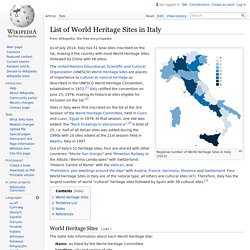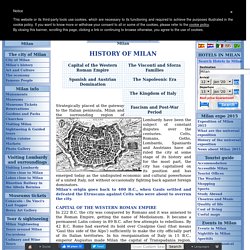

Starting tips. List of World Heritage Sites in Italy. Regional number of World Heritage Sites in Italy (2013) As of July 2014, Italy has 51 total sites inscribed on the list, making it the country with most World Heritage Sites (followed by China with 48 sites).

The United Nations Educational, Scientific and Cultural Organization (UNESCO) World Heritage Sites are places of importance to cultural or natural heritage as described in the UNESCO World Heritage Convention, established in 1972.[1] Italy ratified the convention on June 23, 1978, making its historical sites eligible for inclusion on the list.[2] Sites in Italy were first inscribed on the list at the 3rd Session of the World Heritage Committee, held in Cairo and Luxor, Egypt in 1979. At that session, one site was added: the "Rock Drawings in Valcamonica".[3] A total of 25, i.e. half of all Italian sites was added during the 1990s with 10 sites added at the 21st session held in Naples, Italy in 1997.
World Heritage Sites[edit] The table lists information about each World Heritage Site: Brief History Of Italy And The Population Of Italy. National Geographic. My City: Maximum Milan Here praise for this Italian city and why it should no longer be overshadowed by Florence and Rome.

Europe's Rising Star: Bologna Get to know this Italian city on the rise that magnifies and mixes the best of the country's clichés. Italy Beyond the Bucket List Check out 5 places you should include on your must-see list. Free Things to Do in Milan Known as a fashion and finance capital, check out a side of this Italian city that won't break the bank. Free Things to Do in Rome Rome may be a city of high fashion and expensive tastes, but its rich history and art offer plenty of culture that won't cost you a dime. The Wild Side of Tuscany This fertile region in Italy's heartland offers authenticity and nature on a grand scale. History of Milan. Strategically placed at the gateway to the Italian peninsula, Milan and the surrounding region of Lombardy have been the subject of constant disputes over the centuries.

Celts, Romans, Goths, Lombards, Spaniards and Austrians have all ruled the city at some stage of its history and for the most part, the city has capitalised on its position and has emerged today as the undisputed economic and cultural powerhouse of a united Italy, not without occasionally fighting back against foreign dominators. Milan’s origin goes back to 400 B.C., when Gauls settled and defeated the Etruscans against Celts who were about to overrun the city. In 222 B.C. the city was conquered by Romans and it was annexed to the Roman Empire, getting the name of Mediolanum.
It became a permanent Latin colony in 89 B.C. after few attempts to rebellions. By 42 B.C. Infobase eBooks - Login. Florence and Central Italy, 1400–1600 A.D. Venice and Northern Italy, 1400–1600 A.D. Famous Italians - People From Italy. Aren’t Italians one of the most charming and hardworking people in the world?

Italy might be a small country in terms of her area and population but when it comes to her contributions towards the world, her people simply surpass many other nations much larger in size. Famous Italians (Most Notable Italians in History) Laid the basis of modern violin-making. See Italian luthiers. Dante Alighiericommonly known as Dante, was an Italian poet who greatly influenced generations of poets and authors throughout the centuries, such as Byron, Geoffrey Chaucer and William Blake. He was the author of La Divina Commedia (The Divine Comedy), an allegory of life and God as revealed to a pilgrim, translated into 59 diferent languages since 1400. It is written in terza rima, a three-line rhyme scheme of his own invention and tells the story of a man who endures the torment of Hell (Inferno) and Purgatory (Purgatorio) in his quest to reach Paradise (Paradiso).
Thomas of AquinasTomasso of Aquino was a medieval Catholic priest who greatly influenced thinking and teaching in philosophy. Eugenio Barsantideveloped the first internal combustion engine driven by gas. Giambattista Beccariadiscovered the light sensitivity of silver chloride, an important development in photography. Giovanni CabotoSee: Famous Italian explorers. Famous Italians.